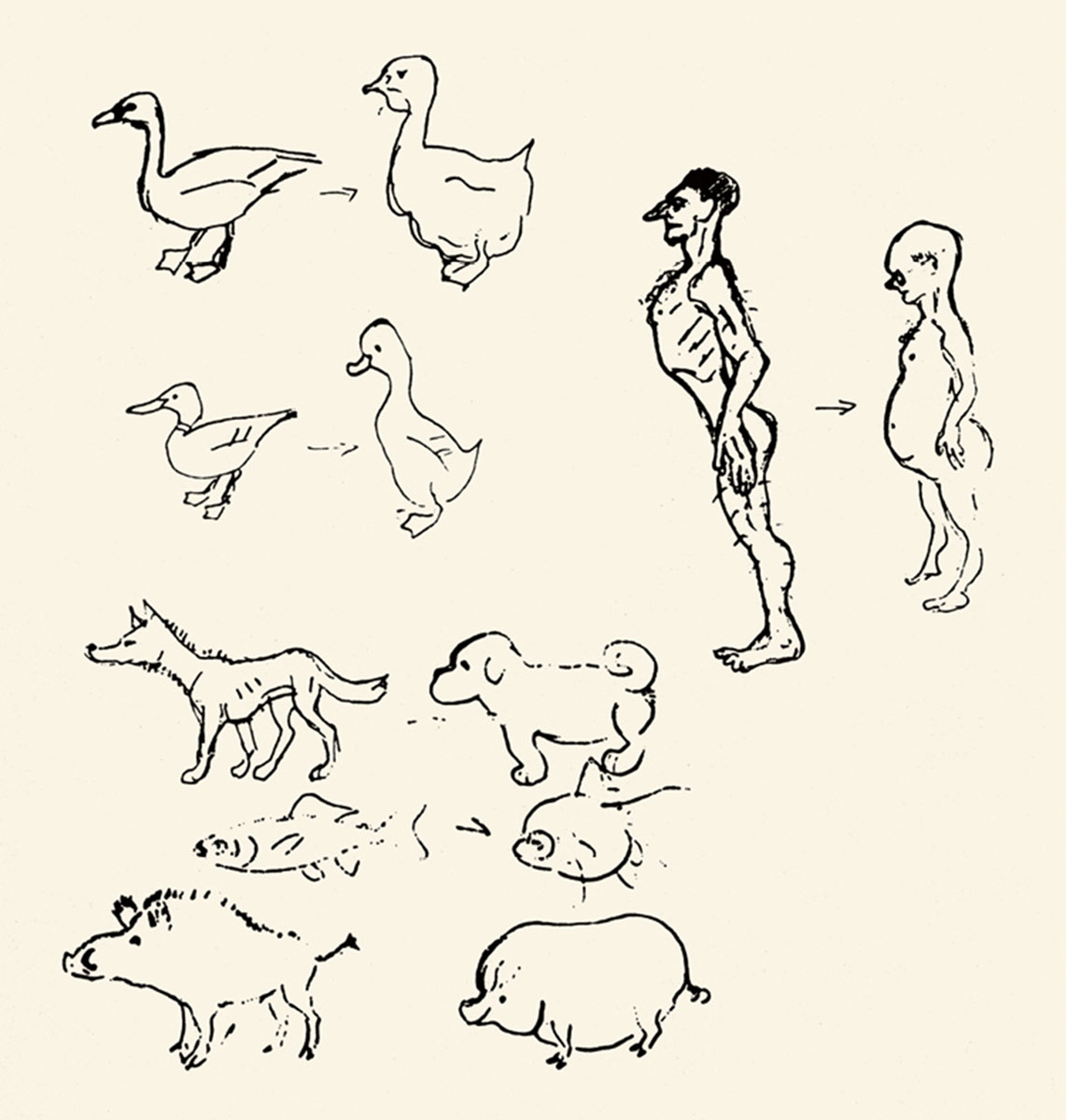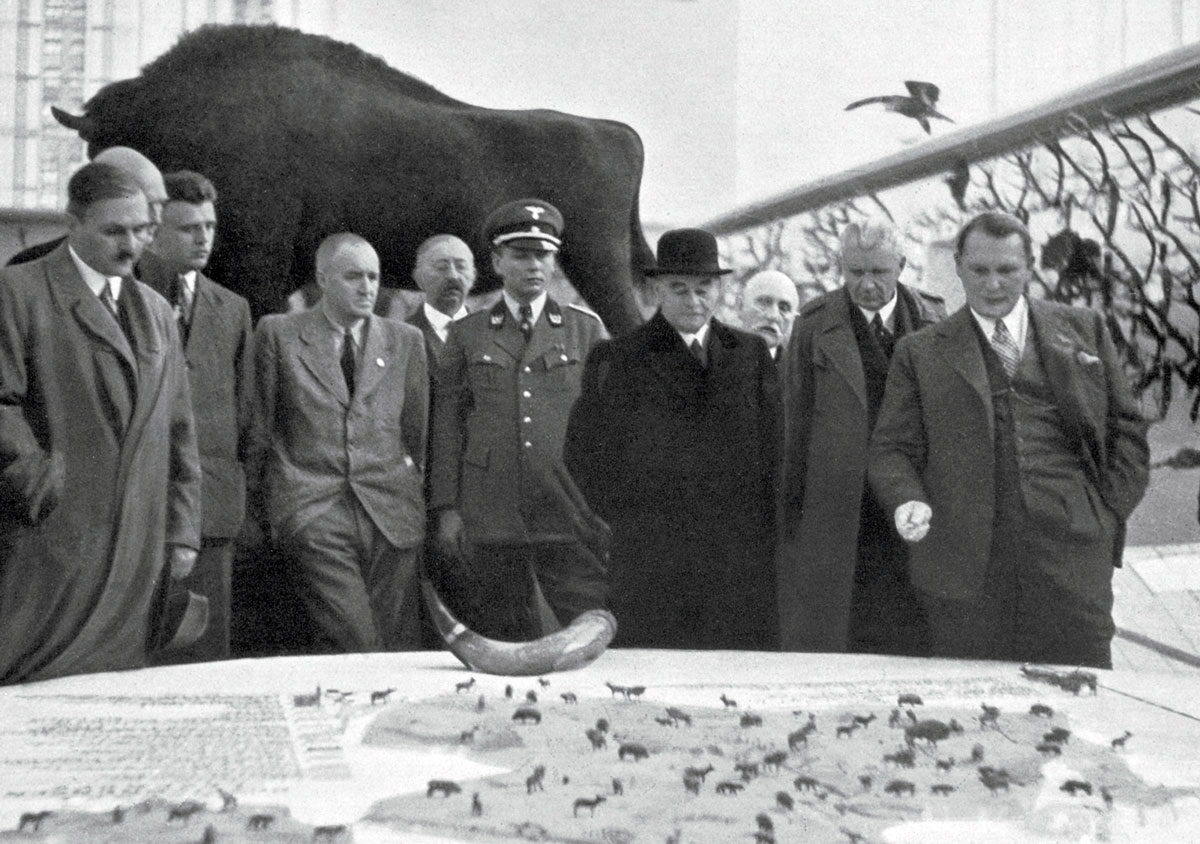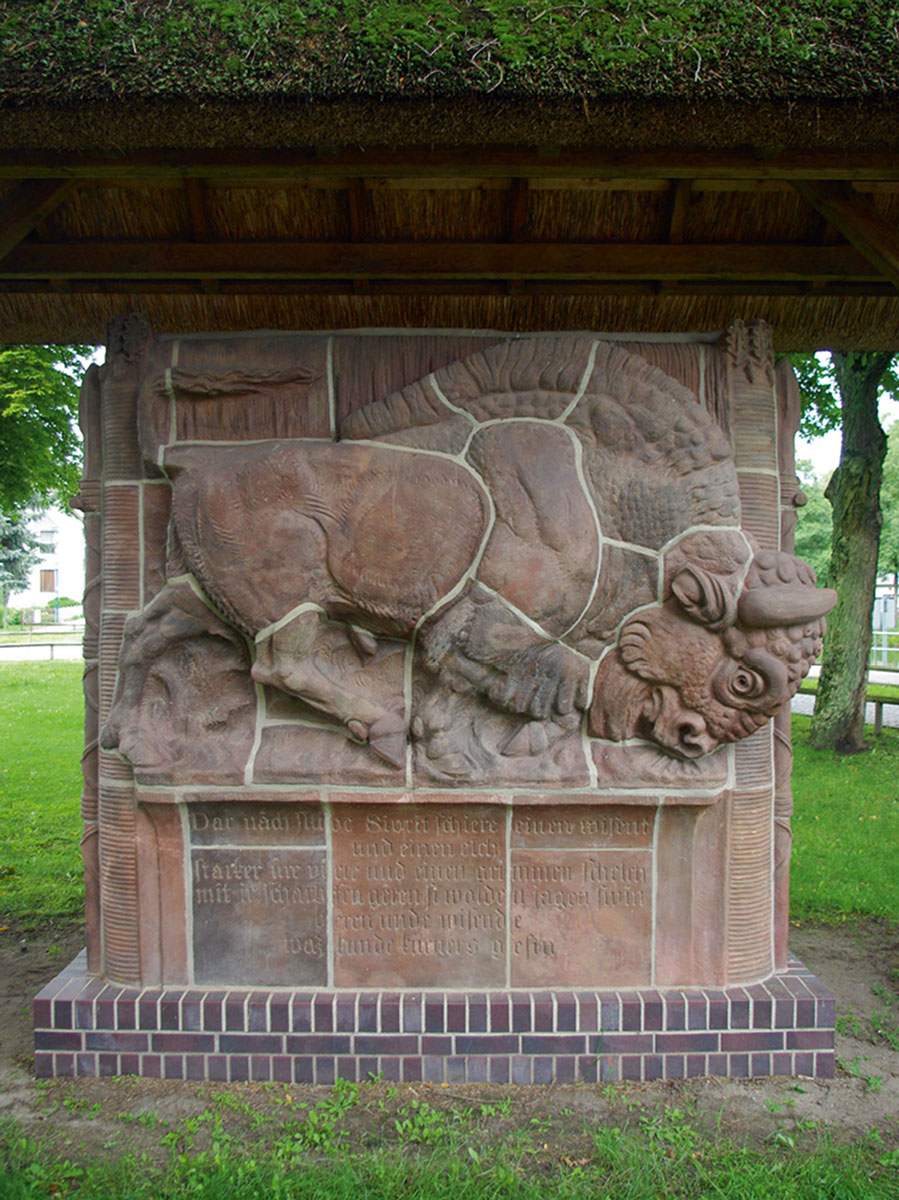Heavy Breeding
The Heck “Aurochs” and the quest for biological unity
Michael Wang
In 1920, the brothers Lutz and Heinz Heck, directors of the Berlin and Munich zoos, respectively, began a two-decade breeding experiment. Working with domestic cattle sought out for their “primitive” characteristics, they attempted to recreate “in appearance and behavior” the living likeness of the animals’ extinct wild ancestor: the aurochs. “Once found everywhere in Germany,” according to Lutz Heck, by the end of the Middle Ages the aurochs had largely succumbed to climate change, overhunting, and competition from domestic breeds.[1]
The last aurochs herds died out in the Polish-Lithuanian Union, where a documented population persisted under royal protection in Mazovia until the middle of the seventeenth century. Historical descriptions of these animals identified the aurochs as similar to domestic oxen, but entirely black, with a whitish stripe running down the back.[2] More distant accounts emphasized their ferocity and imposing size. Julius Caesar described the aurochs of Germania as an elephantine creature prone to unprovoked attack.[3]

For the scholarly world, the memory of the aurochs was preserved in a 1550s appendix to Conrad Gesner’s Historiae animalium. Intended to distinguish this nearly vanished animal from Europe’s other species of wild cattle, the European bison, the mention formally reinscribed the aurochs into the annals of zoological science. Over 350 years after its publication, this encyclopedia of animals both real and imagined (satyrs and sea monsters appear alongside hedgehogs and hippopotamuses) served, for the Heck brothers, as a key source on the extinct aurochs. This, along with a handful of artistic representations, formed the basis of the Heck brothers’ wild ideal. Their research cited copies of the lost “Augsburg Picture” (which is thought, today, to have represented a domestic bull), a 1730 Meissen porcelain group by Kändler depicting a pack of hounds encircling a wounded bull (whose piebald coloration should have similarly suggested a domesticated subject), and the prehistoric cave paintings at the Abrigo de los Toros in Spain. The Hecks’ aurochs would be the culmination of an erratic trip through Western art history, from its primeval origins up to Baroque naturalism. Through a mimetic reversal, the breeding process sought to restore attributes known only through human cultural products. While the project took up widely held scientific theories of inheritance and conformed to the natural historical conception of the aurochs as the sole progenitor of domestic cattle (a view familiar at least since Georges Cuvier’s 1812 Recherches sur les ossemens fossiles de quadrupèdes), the Heck brothers’ biological means served primarily aesthetic ends.
This conflation of biological and aesthetic destiny coincided with a strain of Nazi thought that sought to apply pseudo-Darwinian theories in support of a racialized conception of the state. In this mode, the zoologist Konrad Lorenz identified parallels between the changes he observed in animals as the result of their domestication and what he saw as the deleterious genetic effects of civilization. Among the traits shared by domesticated animals and city dwellers were a supposed increase in phenotypic variation (novel coloration, for instance), neoteny (the retention of juvenile features, as in the short face of a Pekinese), atrophy of the muscles, and an increase in sexual activity and fertility. These traits were not only dangerous signs of degeneration; they were also aesthetically displeasing. In his 1940 article “Durch Domestikation verursachte Störungen arteigenen Verhaltens” (Domestication-induced disorders of species-typical behavior), Lorenz presented a series of images of Roman sculptures, comparing the “beautiful” (an Olympian) with the “ugly” (a satyr or, even, a bust of Socrates). These art-historical valuations were extended to wild animals and their domestic counterparts: wolves and dogs, boars and pigs, mouflon and sheep, jungle fowl and barnyard roosters. For Lorenz, the wild ancestor (the photographs of which were mostly acquired from Oskar Heinroth, Lutz Heck’s associate at the Berlin Zoo) were consistently deemed the more beautiful. This aesthetic response, Lorenz theorized, was also an inborn survival strategy.

Beauty was, for Lorenz, the outward sign of a “biological unity.” Domestication, with its attendant increase in variation and “mutations,” was a process of decay. The evolutionary unity of the wild form deteriorates into aberrant types. For the Hecks, the idea of the aurochs was precisely that of a lost genetic unity—the fragments of which persisted, scattered among diverse domestic cattle breeds. Their task would be the re-stitching of these genetic fragments. Lutz Heck recounted:
Much as a mosaic picture may be separated into its individual tesserae, the heritable constitution of a living being can be split up in the hereditary process and its elements passed on separately to descendents. If we carry this theory to the case of domestic cattle as descendents of the wild aurochs, we see in them the heritable constitution of the aurochs so divided up that out of many races and breeds of cattle each one has only a part of the original heritable constitution of wild cattle. What my brother and I now had to do was to unite in a single breeding stock all those characteristics of the wild animal which are now found only separately in individual animals.[4]In Lorenz’s conception, however, biological unity extended beyond the physical and behavioral attributes of the animal itself. Following on the work of the Estonian biologist Jakob von Uexküll, Lorenz understood an organism as essentially linked to its environment. Together, organism and environment formed a “unified functional cycle,” a phenomenon that Lorenz observed exclusively in relation to wild animals.[5] Just as Lorenz saw the effects of domestication as deleterious fragmentation (the modification of discrete traits), the original act of domestication was itself a kind of fragmentation. Domestication severed an organism from its natural place within an environmental whole.

According to this system, then, the recreation of the aurochs would be incomplete were this animal to be confined to the artificial sphere of a zoological garden. To restore the biological unity of the aurochs would require the restoration of its original environs. In the imagination of the Hecks and their research patron—Reichsjägermeister Hermann Göring—this environment was not in fact entirely lost to time. The ideal site for the introduction of the Heck aurochs would be the primeval forest of Białowieża, one of the last old-growth forests remaining in Europe. At the border of Poland and Belarus, the forest had been historically protected as the privileged hunting grounds of Polish kings and Russian tsars.
In a photograph from the International Hunting Exposition of 1937 in Berlin, Göring and Lutz Heck survey a relief map of Białowieża populated by tiny figurines of elk, bison, and deer.[6] Resting atop the map is a curving horn, very much like the “sturdy white horns tipped with black” that Heck described, in a contemporary visitors’ guide to the Berlin zoo, as characteristic of the regenerated aurochs.[7] If this is indeed a horn from a Heck bull, its exhibition anticipated the 1942 introduction of the regenerated aurochs to Białowieża—a region “so uniquely suited to this purpose”—during the period when, as Lutz Heck passively recalled less than a decade after the war, the forest had come for a few years “under German administration.”[8]
Following the German occupation of eastern Poland in 1941, Göring envisioned the transformation of Białowieża into a vast game reserve. The agenda dovetailed with the Hecks’ back-breeding programs. One of the last European forests largely undisturbed since the Ice Age, Białowieża also sheltered rare game animals: bears, wolves, capercaillies, and the last of the lowland European bison, an animal which appears alongside the aurochs in Lutz Heck’s constellation of ancient German game. Heck recalled:
In my youth my imagination was caught by the famous description in the Nibelungenlied of Siegfried’s hunt in the forest of the Vosges. … I was interested above all in the two huge wild oxen, which have become almost legendary but are regarded as the most powerful representatives of primeval German game—the European bison and the aurochs.[9]

The reintroduction of these two animals into the German landscape was part of a larger project of constructing a national identity based on mythic foundations. Germany under the Third Reich would be restored to the Germany of the Nibelungenlied. Göring, a modern Siegfried, would revive the ancient hunting campaigns for increasingly rare—or reconstructed—species. To realize this historical fantasy, however, required a series of spatial and temporal displacements. While Göring traveled east to Białowieża to seek Germany’s lost game, the Hecks arranged for the export of Białowieża’s bison west to Schorfheide, Göring’s reserve north of Berlin. There, they were integrated into ongoing efforts to cross European bison with Canadian wood bison in an attempt to strengthen the diminished European genetic stock. Subsequent breeding would then restore a more European phenotype, while carrying over the “robustness” of the American. The primary goal was increased fertility, which was necessary to populate Göring’s hunting grounds. The Nibelungenlied passage that Heck cites reappeared at the base of a monument—a charging bison in Meissen stoneware—erected to commemorate the success of the breeding program at Schorfheide. The inscription on the back of the sculpture, addressed to a future when Göring’s estate would have vanished from memory, eulogized the park as an “asylum” for bison, elk, deer, and (reconstructed) aurochs. These animals themselves would provide “living testimony” to a lost age when Germany was “not yet ruled by Man.”
In Białowieża, this dream of a wilderness untouched by human hands helped justify the murderous campaigns carried out under the banner of Germanization. To prepare the area for German settlement, the forest would be cleared of its non-Aryan occupants. Under Göring’s directives, mass deportations and executions targeted Białowieża’s Jewish inhabitants, Polish resistance fighters, and Soviet partisans. These campaigns of death were, however paradoxically, intimately tied to a particular nationalistic conception of life: the pursuit of “living space” (Lebensraum). Lebensraum mixed political, military, and economic objectives with the language and concepts of the life sciences. In Białowieża, the appropriation of land and natural resources for German use would assume the scientific guise of “forest management.” The Polish biologist Tadeusz Vetulani described this dual program—of human extermination and animal propagation—as the German “management” of Białowieża:
This “management,” which, during World War I, was marked by over-felling of trees and over-exploitation of wildlife—bison, elk and deer in particular—during World War II brought further, and even more gruesome and elaborate, exploitation not only of our natural resources and material goods but also of our blood—in the most literal sense—and religious heritage.[10]Like the Hecks, Vetulani had dedicated himself to the restoration of extinct European mammals. His work revolved around the Konik ponies, a Polish breed that traced its bloodline to Białowieża’s last wild tarpans—ancestor of the domestic horse. Vetulani had reintroduced selectively bred Koniks to Białowieża. His research, however, aligned with that of the Hecks too well. During the war, the Hecks rounded up these horses to supply their own tarpan breeding programs in Munich and Berlin. Vetulani’s anguish over the “exploitation” of Polish blood here takes on another literal meaning: even as German forces shot down partisans in Białowieża’s swamps, the Hecks drained Białowieża of its unique mammals, prized for the purity of their “primitive” blood. As with the bison program, the breeding of the Heck horse relied on this transfusion from east to west.
What the Hecks saw as the restoration of an ancient unity—the reconstruction of a lost “Germanic” species—was, for Vetulani, a “baffling” campaign of destruction. Bred from animals with eighteenth-century roots in the Białowieża forest, the Konik pony breeding program was, as Vetulani recounted, “meant to bring back to Białowieża her primeval inhabitant.” Lutz Heck’s decision to “uproot” the Koniks from Białowieża “thus brutally stopped the breeding experiment.”[11]
The Hecks’ back-breeding projects themselves would continue only a short while longer. When the Allied bombs rained down on Berlin for two nights in January 1944, what remained of the battered zoological gardens went up in flames. Animals succumbed to shrapnel wounds or burned to death in their cages. Dangerous species broke loose and were shot. Such was the fate of the Heck aurochs. Lutz Heck’s son gunned down the agitated and stampeding aurochs, together with warthogs and wild boar, after they had escaped their burning enclosures.
Ten months later, following the war, when the director of the Białowieża forest, Jan Jerzy Karpiński, was able to return safely to Poland, he was met with rumors of strange animals left behind by the retreating Germans. In a letter to the State Council for Nature Conservation, Karpiński reported:
At the end of October 1944, when I took charge of the Białowieża National Park again, I was informed that of the buffaloes let out by the Germans, 8 to 12 still remain in the forest. I was perfectly aware, of course, that these were not real buffaloes, but most probably regenerated aurochs from the Romincka Forest (which was later officially corroborated).[12]As the Hecks had envisioned, their regenerated aurochs persisted in a semi-wild state in the Białowieża forest. When Lutz Heck heard that some of the animals had survived the war, he proudly cited this fact as evidence of their suitability to the natural environs. To the Polish forestry service, however, the stray cattle were profoundly unnatural: they had no place in the forest as it had been known for hundreds of years. At Karpiński’s request, a provisional corral was built with the intention of capturing the Heck animals, which, forestry officials correctly assumed, would not survive on their own. The post–World War II revision of Poland’s borders hindered this task. Białowieża forest had been carved in two, with the eastern side under Soviet jurisdiction. By crossing the border into Belarus for increasingly long periods, the Heck aurochs evaded the Polish foresters, and most likely soon perished. “It seems that nothing can be done at this point,” Karpiński lamented, “to save the remaining animals from extinction.”[13]
The Heck aurochs did not altogether disappear. At the Munich zoo, Heinz Heck’s aurochs survived the war unharmed. Heck cattle—as the breed is known today—trace their lineage to these animals. There have even been recent attempts, in the Netherlands and elsewhere, to introduce the breed into state nature reserves as surrogates for the megafauna that once grazed on lowland grasses. But the Heck fantasy of the aurochs no longer clings to these animals, despite their atavistic features, and the aurochs itself, Bos primigenius, has lost much of its unique scientific status. Current nomenclature no longer distinguishes the aurochs as a species distinct from domestic cattle.
The realization of the Hecks’ wild ideal proved unsustainable. Their vision of biological reunification continually sought to expand its borders: from the regeneration of a single animal to the violent reshaping of an entire landscape. No curve of a horn, or shade of an eel-striped coat could satisfy this totalizing vision. Ultimately, the Hecks’ biological methods were inadequate to their task—for the aurochs was not a species, but a symbol.
- Lutz Heck, Wegweiser durch den Zoologischen Garten Berlin (Berlin: Aktien-verein des Zoologischen Gartens zu Berlin, 1941), p. 53. My translation.
- Sigmund Freiherr von Herberstein, Rerum Moscoviticarum Commentarii (Basel: Johannes Oporinus, 1556).
- Julius Caesar, The Gallic War, trans. Carolyn Hammond (Oxford: Oxford University Press: 1996), bk. 6, sec. 28.
- Lutz Heck, Animals: My Adventure, trans. E. W. Dickes (London: Methuen, 1954), p. 143.
- Konrad Lorenz, “Durch Domestikation verursachte Störungen arteigenen Verhaltens,” Zeitschrift für angewandte Psychologie und Charakterkunde, no. 59 (1940).
- The photograph appears in Waidwerk der Welt: Erinnerungswerk an die internationale Jagdausstellung Berlin 1937, 2.–28. November (Berlin: Paul Parey, 1938).
- Lutz Heck, Wegweiser, op. cit., p. 53.
- Lutz Heck, Animals: My Adventure, op. cit., p. 154.
- Ibid., p. 139.
- Tadeusz Vetulani, “Co słychać w Puszczy Białowieskiej?,” Ziemia, no. 5 (1946), p. 4. Translation by Mikołaj Szajna.
- Ibid., p. 7.
- Jan Jerzy Karpiński, letter to State Council for Nature Conservation, 4 May 1946, the State Archive in Białystok, Poland. Translation by Mikołaj Szajna.
- Ibid.
Michael Wang is an artist and writer based in New York City. His solo show “Carbon Copies” was exhibited at Foxy Production in January 2012. He is currently writing a book with Peter Eisenman on architecture under late capitalism.
Spotted an error? Email us at corrections at cabinetmagazine dot org.
If you’ve enjoyed the free articles that we offer on our site, please consider subscribing to our nonprofit magazine. You get twelve online issues and unlimited access to all our archives.